Abstract
With a leaf disc assay, 11 species were tested for effects of the herbicide acifluorfen on porphyrin accumulation in darkness and subsequent electrolyte leakage and photobleaching of chlorophyll after exposure to light. Protoporphyrin IX (Proto IX) was the only porphyrin that was substantially increased by the herbicide in any of the species. However, there was a wide range in the amount of Proto IX accumulation caused by 0.1 millimolar acifluorfen between species. Within species, there was a reduced effect of the herbicide in older tissues. Therefore, direct quantitative comparisons between species are difficult. Nevertheless, when data from different species and from tissues of different age within a species were plotted, there was a curvilinear relationship between the amount of Proto IX caused to accumulate during 20 hours of darkness and the amount of electrolyte leakage or chlorophyll photobleaching caused after 6 and 24 hours of light, respectively, following the dark period. Herbicidal damage plateaued at about 10 nanomoles of Proto IX per gram of fresh weight. Little difference was found between in vitro acifluorfen inhibition of protoporphyrinogen oxidase (Protox) of plastid preparations of mustard, cucumber, and morning glory, three species with large differences in their susceptibility at the tissue level. Mustard, a highly tolerant species, produced little Proto IX in response to the herbicide, despite having a highly susceptible Protox. Acifluorfen blocked carbon flow from δ-aminolevulinic acid to protochlorophyllide in mustard, indicating that it inhibits Protox in vivo. Increasing δ-aminolevulinic acid concentrations (33-333 micromolar) supplied to mustard with 0.1 millimolar acifluorfen increased Proto IX accumulation and herbicidal activity, demonstrating that mustard sensitivity to Proto IX was similar to other species. Differential susceptibility to acifluorfen of the species examined in this study appears to be due in large part to differences in Proto IX accumulation in response to the herbicide. In some cases, differences in Proto IX accumulation appear to be due to differences in activity of the porphyrin pathway.
Full text
PDF
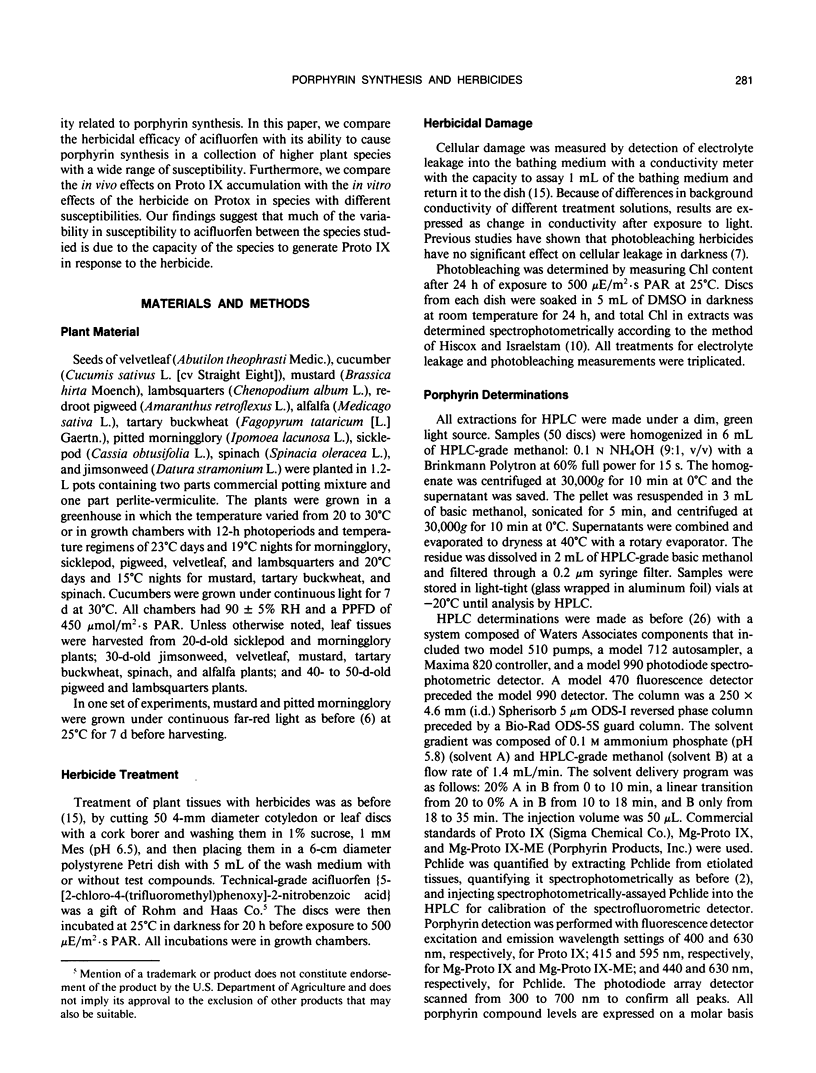
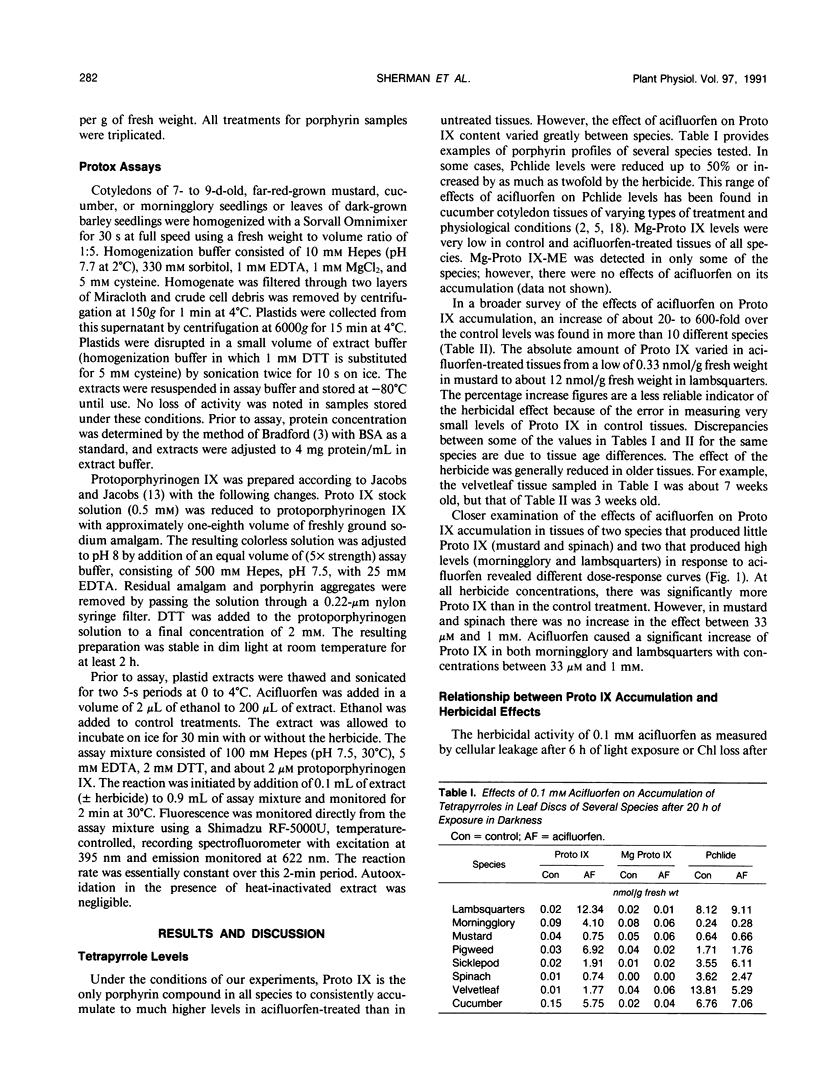
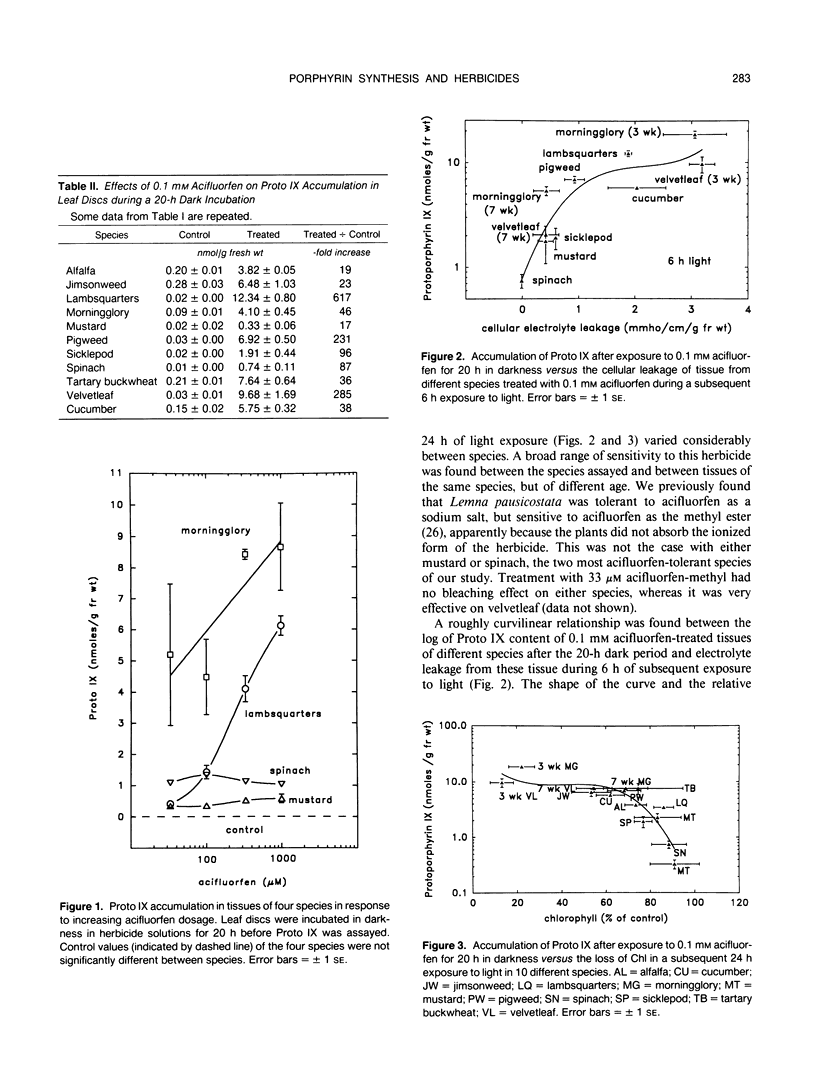
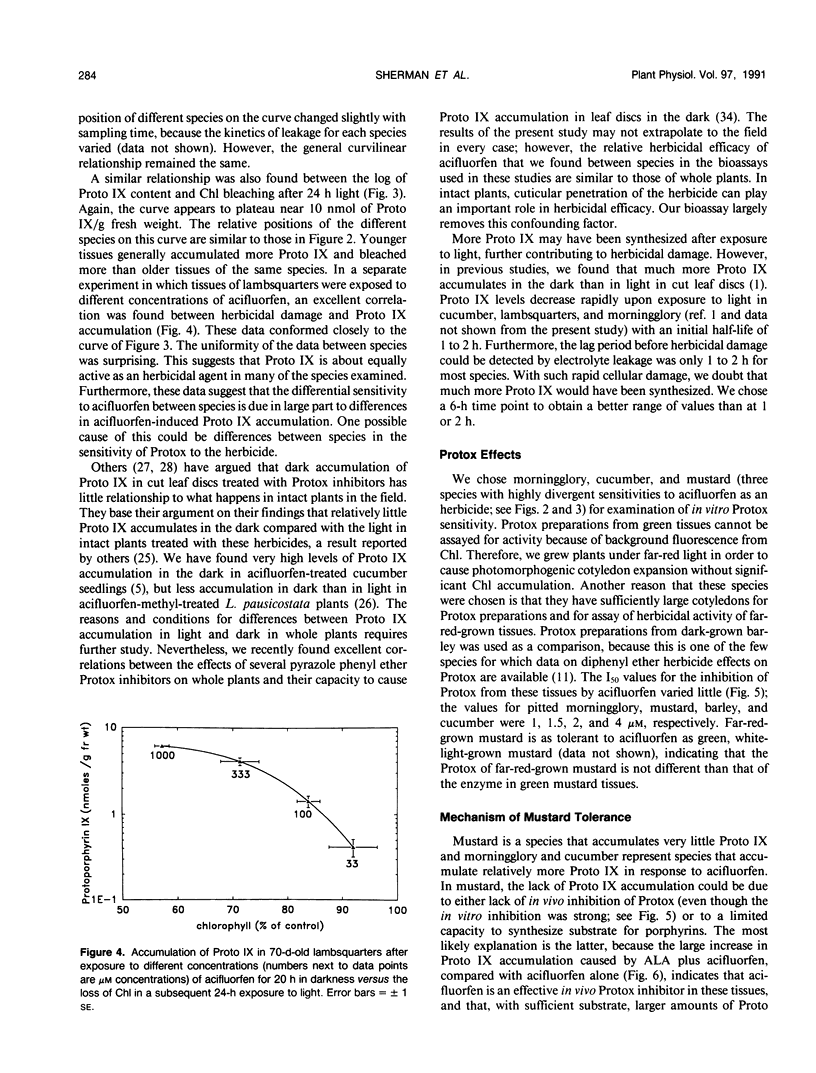
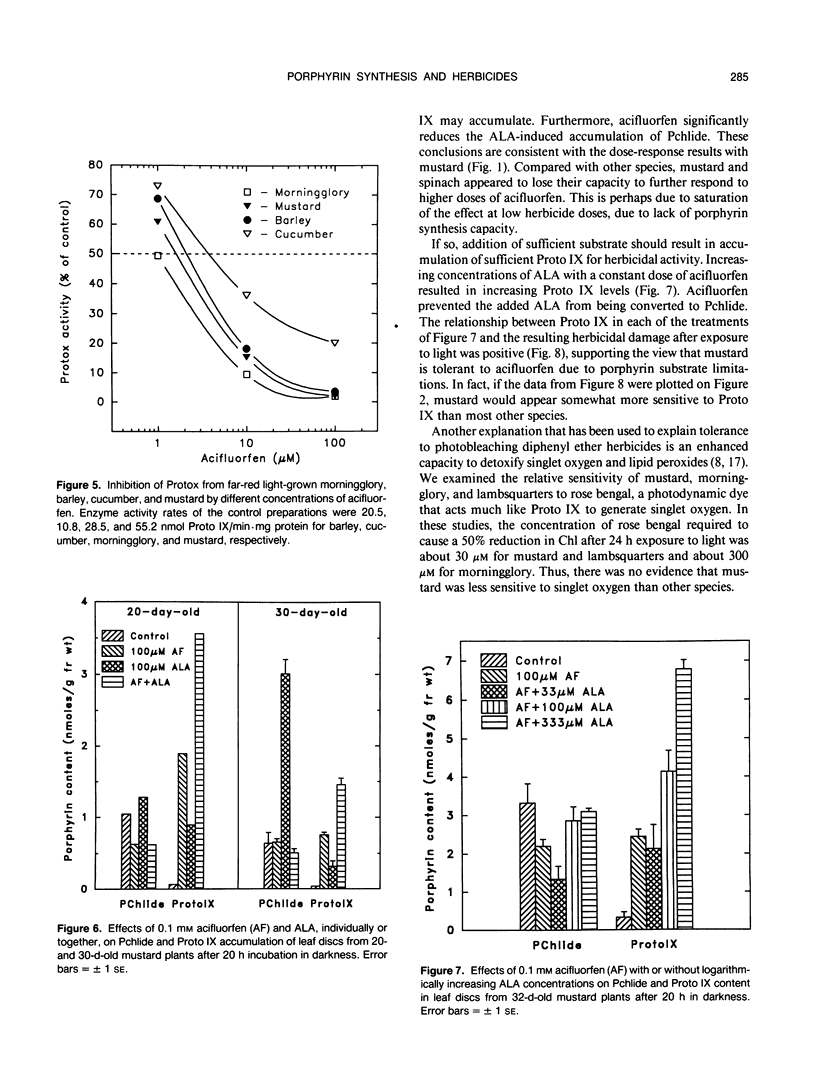

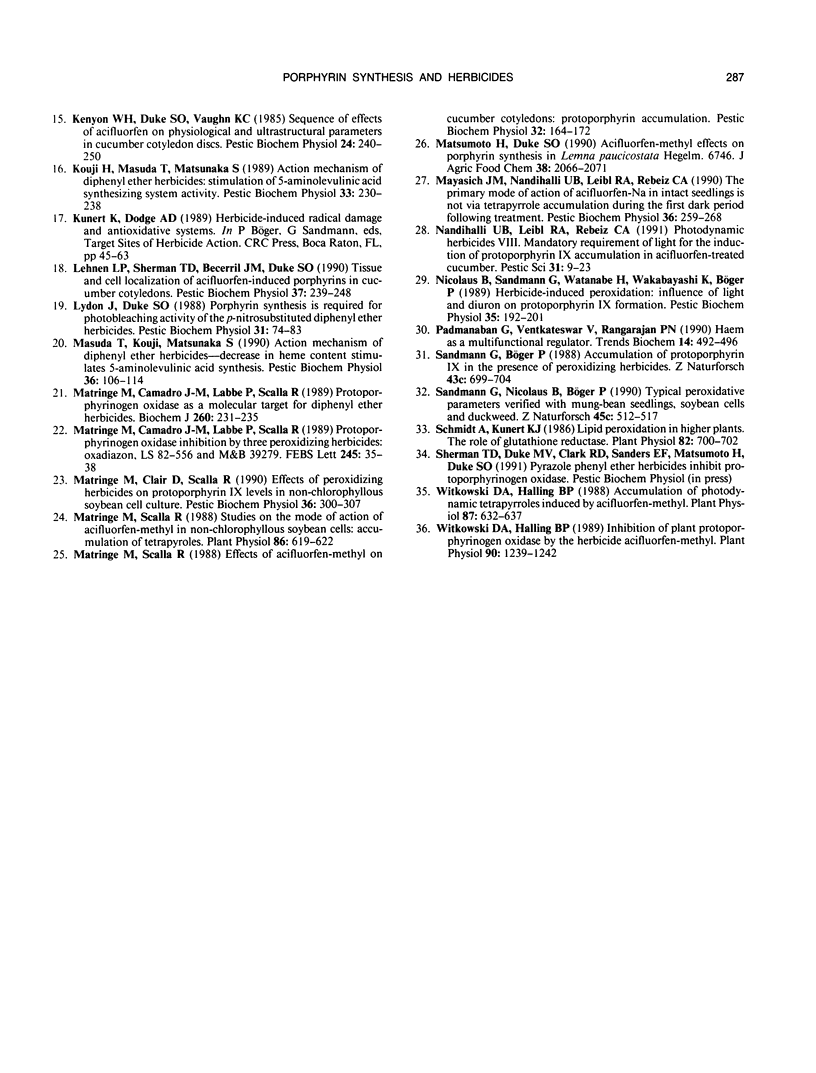
Selected References
These references are in PubMed. This may not be the complete list of references from this article.
- Becerril J. M., Duke S. O. Protoporphyrin IX Content Correlates with Activity of Photobleaching Herbicides. Plant Physiol. 1989 Jul;90(3):1175–1181. doi: 10.1104/pp.90.3.1175. [DOI] [PMC free article] [PubMed] [Google Scholar]
- Bradford M. M. A rapid and sensitive method for the quantitation of microgram quantities of protein utilizing the principle of protein-dye binding. Anal Biochem. 1976 May 7;72:248–254. doi: 10.1006/abio.1976.9999. [DOI] [PubMed] [Google Scholar]
- Deybach J. C., de Verneuil H., Nordmann Y. The inherited enzymatic defect in porphyria variegata. Hum Genet. 1981;58(4):425–428. doi: 10.1007/BF00282829. [DOI] [PubMed] [Google Scholar]
- Duke S. O., Kenyon W. H. Photosynthesis Is Not Involved in the Mechanism of Action of Acifluorfen in Cucumber (Cucumis sativus L.). Plant Physiol. 1986 Jul;81(3):882–888. doi: 10.1104/pp.81.3.882. [DOI] [PMC free article] [PubMed] [Google Scholar]
- Jacobs J. M., Jacobs N. J., Borotz S. E., Guerinot M. L. Effects of the photobleaching herbicide, acifluorfen-methyl, on protoporphyrinogen oxidation in barley organelles, soybean root mitochondria, soybean root nodules, and bacteria. Arch Biochem Biophys. 1990 Aug 1;280(2):369–375. doi: 10.1016/0003-9861(90)90344-x. [DOI] [PubMed] [Google Scholar]
- Jacobs J. M., Jacobs N. J., Sherman T. D., Duke S. O. Effect of diphenyl ether herbicides on oxidation of protoporphyrinogen to protoporphyrin in organellar and plasma membrane enriched fractions of barley. Plant Physiol. 1991 Sep;97(1):197–203. doi: 10.1104/pp.97.1.197. [DOI] [PMC free article] [PubMed] [Google Scholar]
- Jacobs N. J., Jacobs J. M. Assay for enzymatic protoporphyrinogen oxidation, a late step in heme synthesis. Enzyme. 1982;28(2-3):206–219. doi: 10.1159/000459103. [DOI] [PubMed] [Google Scholar]
- Kenyon W. H., Duke S. O. Effects of Acifluorfen on Endogenous Antioxidants and Protective Enzymes in Cucumber (Cucumis sativus L.) Cotyledons. Plant Physiol. 1985 Nov;79(3):862–866. doi: 10.1104/pp.79.3.862. [DOI] [PMC free article] [PubMed] [Google Scholar]
- Matringe M., Camadro J. M., Labbe P., Scalla R. Protoporphyrinogen oxidase as a molecular target for diphenyl ether herbicides. Biochem J. 1989 May 15;260(1):231–235. doi: 10.1042/bj2600231. [DOI] [PMC free article] [PubMed] [Google Scholar]
- Matringe M., Camadro J. M., Labbe P., Scalla R. Protoporphyrinogen oxidase inhibition by three peroxidizing herbicides: oxadiazon, LS 82-556 and M&B 39279. FEBS Lett. 1989 Mar 13;245(1-2):35–38. doi: 10.1016/0014-5793(89)80186-3. [DOI] [PubMed] [Google Scholar]
- Matringe M., Scalla R. Studies on the mode of action of acifluorfen-methyl in nonchlorophyllous soybean cells : accumulation of tetrapyrroles. Plant Physiol. 1988 Feb;86(2):619–622. doi: 10.1104/pp.86.2.619. [DOI] [PMC free article] [PubMed] [Google Scholar]
- Padmanaban G., Venkateswar V., Rangarajan P. N. Haem as a multifunctional regulator. Trends Biochem Sci. 1989 Dec;14(12):492–496. doi: 10.1016/0968-0004(89)90182-5. [DOI] [PubMed] [Google Scholar]
- Schmidt A., Kunert K. J. Lipid peroxidation in higher plants : the role of glutathione reductase. Plant Physiol. 1986 Nov;82(3):700–702. doi: 10.1104/pp.82.3.700. [DOI] [PMC free article] [PubMed] [Google Scholar]
- Witkowski D. A., Halling B. P. Accumulation of photodynamic tetrapyrroles induced by acifluorfen-methyl. Plant Physiol. 1988 Jul;87(3):632–637. doi: 10.1104/pp.87.3.632. [DOI] [PMC free article] [PubMed] [Google Scholar]
- Witkowski D. A., Halling B. P. Inhibition of plant protoporphyrinogen oxidase by the herbicide acifluorfen-methyl. Plant Physiol. 1989 Aug;90(4):1239–1242. doi: 10.1104/pp.90.4.1239. [DOI] [PMC free article] [PubMed] [Google Scholar]


